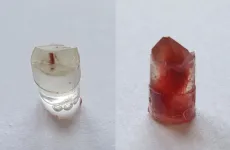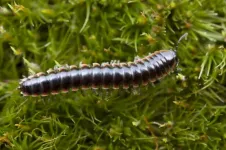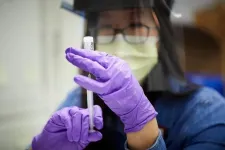(Press-News.org) In less than a second, a small sensor used in brain chemistry research can detect the key molecules that provide the genetic instructions for life, RNA and DNA, a new study from American University shows.
The AU researchers believe the sensor is a useful tool for scientists engaged in clinical research to measure DNA metabolism, and that the sensor could be a quick way for lab clinicians to distinguish 'healthy' from 'sick' samples and determine if a pathogen is fungal, bacterial, or viral, before conducting further analysis.
To explore whether the sensors could detect RNA and DNA, Alexander Zestos, assistant professor of chemistry, teamed up with John Bracht, associate professor of biology, to test a new method for detection of RNA and DNA. Both professors are part of AU's Center for Neuroscience and Behavior, which brings together researchers from a variety of fields to investigate the brain and its role in behavior.
Novel Electrode Measures RNA and DNA
The sensors, also known as carbon fiber microelectrodes, allow researchers like Zestos to conduct precise measurement of chemicals in the brain. Researchers can learn more about the brain's complex circuitry of neural pathways and neurotransmitters, chemicals in the brain that pass messages along a given pathway.
Zestos and Bracht used a typical carbon fiber microelectrode with fast scan cyclic voltammetry, the same kind of sensor used to detect dopamine in the brain. Zestos' work frequently involves using sensors to detect and measure dopamine in the brain, because the neurotransmitter figures in a wide range of activity in the nervous system, from bodily movements to emotional responses.
The researchers modified the sensor with a specialized electrode. They weren't sure that it would work, and were surprised when the electrode, or waveform, detected the oxidative peaks of adenosine and guanosine, two of the building blocks of DNA. The detection time is fast, occurring in less than a second. Research methods were verified using both animal and synthetic RNA and DNA.
A Research Tool and Pre-Diagnostic
In the near term, Bracht and Zestos envision the tool as useful in clinical research. Researchers who use the tool could gain useful information about nucleic acids and measure the relative ratios of adenosine, guanosine and cytidine, another DNA nucleobase. Around the size of a strand of human hair, the sensor is small enough to implant in cells, tissue, or in live organisms. The sensor can detect DNA or RNA in any fluid sample, including liquid droplets, saliva, blood or urine.
The sensor could also be used as a pre-diagnostic. The onset of disease or fungal infection can cause a quick rise in nucleic acids, which the sensor can measure, and possibly predict rapid infections, the researchers said. It can take up to a day or more for results from tests for coronavirus, for example.
"Electrochemical sensors can be used for evaluating samples prior to sequence-based methods," Bracht said. "We can envision several cases where clinically it's useful to quickly measure DNA or RNA in a sample before further sequencing. For example, it might be used when there are a lot of samples to quickly check before doing more extensive testing."
One current limitation is the sensor will need to detect more than just the strands of DNA and RNA. To detect a specific virus or for genetic testing, the sensor will need to detect the gene sequence of a virus. A next step in the research will be to modify the sensor further to see if the sensor can detect a virus. The sensor potentially has a variety of applications for which further research will be needed, including within forensic science and other fields where sensors play a prominent role.
"We have also thought about whether we can measure DNA metabolism inside living brains and cells," Bracht said. "We could possibly use one electrode to measure neurotransmitters like dopamine and also measure DNA and RNA and their building blocks in real-time in a brain."
INFORMATION:
The new research published in the chemistry journal ACS Omega was funded with a Pittcon Starter Grant Award of $50,000 from the Society for Analytical Chemists of Pittsburgh. Recent AU graduates Favian Lu and Thomas Asrat contributed to the research.
The Pazyryk carpet is the world's oldest example of a knotted-pile carpet and is kept at the State Hermitage Museum in St. Petersburg, Russia. The carpet, which was made out of new wool at around 400 BC, is one of the most exciting examples of central Asian craftsmanship from the Iron Age. Ever since the carpet was discovered in 1947 by Russian archaeologists in a kurgan tomb in the Altai mountains, experts in traditional dyeing techniques have been puzzled by the vivid red, yellow and blue colours of the carpet, which lay buried in extreme conditions for almost two thousand five hundred years.
Red fibres ...
You didn't need a Ph.D. to contribute to research into wildlife abundance and behavior in North Carolina, thanks to a large-scale citizen science project led by North Carolina State University researchers.
Through the project, called North Carolina Candid Critters, researchers trained 580 volunteers to take candid animal photos with heat sensitive cameras, and then share their photos through a website called eMammal. In an article on the project in the journal Citizen Science: Theory and Practice, researchers reported on the successes and challenges of the effort, which gathered more than 2.2 million wildlife photos across three years, and increased the number of verified mammal records that were available in the state by a factor of five.
"The power of this is that you can get ...
What The Article Says: This Viewpoint proposes ways to maximize vaccine efficacy and allocation given the rise of coronavirus variants and authorization of a Johnson & Johnson vaccine, including reserving the latter for younger healthier populations, boosting it with a single-dose messenger RNA (mRNA) vaccination and single mRNA immunization of people with prior documented SARS-CoV-2 infection.
Authors: John P. Moore, Ph.D., of Weill Cornell Medicine in New York, is the corresponding author.
To access the embargoed study: Visit our For The Media website at this link https://media.jamanetwork.com/
(doi:10.1001/jama.2021.3465)
Editor's Note: The article includes an Editor's Note. Please see the article for additional information, including other authors, author ...
Many cognitive neurodevelopmental disorders are a result of too many or too few copies of certain genes or chromosomes. To date, no treatment options exist for this class of disorders. MECP2 duplication syndrome (MDS) is one such disorder that primarily affects boys and results from a duplication spanning the methyl-CpG binding protein 2 (MECP2) locus located on the X chromosome.
A preclinical study published from the laboratory of Dr. Huda Zoghbi, professor at Baylor College of Medicine and director of the Jan and Dan Duncan Neurological Research Institute at Texas Children's Hospital, provides experimental evidence that supports the use of antisense oligonucleotides as ...
BOSTON - New treatments for Alzheimer's disease are desperately needed, but numerous clinical trials of investigational drugs have failed to generate promising options. Now a team at Massachusetts General Hospital (MGH) and Harvard Medical School (HMS) has developed an artificial intelligence-based method to screen currently available medications as possible treatments for Alzheimer's disease. The method could represent a rapid and inexpensive way to repurpose existing therapies into new treatments for this progressive, debilitating neurodegenerative condition. ...
Hearing the words "new species discovered" may conjure images of deep caves, uncharted rainforests, or hidden oases in the desert.
But the reality is that thousands of new species are discovered each year by enterprising scientists all over the world. Many of these new species do come from exotic locations, but more surprisingly, many come from just down the road, including the newest member of the Hokie Nation, the millipede Nannaria hokie.
The newest Hokie -- which has about 60 more legs than the HokieBird -- was discovered living under rocks by the Duck Pond behind the Grove on Virginia Tech's Blacksburg campus. Since then, the critter has been found at the area commonly referred to as stadium ...
New research at Washington University School of Medicine in St. Louis indicates that three new, fast-spreading variants of the virus that cause COVID-19 can evade antibodies that work against the original form of the virus that sparked the pandemic. With few exceptions, whether such antibodies were produced in response to vaccination or natural infection, or were purified antibodies intended for use as drugs, the researchers found more antibody is needed to neutralize the new variants.
The findings, from laboratory-based experiments and published March 4 in Nature Medicine, suggest that COVID-19 drugs and vaccines developed thus far may become less effective ...
Texas A&M University College of Medicine ressearchers have recently discovered that cytisine -- a smoking cessation drug commonly used in Europe -- reduces the loss of dopamine neurons in females. These findings provide potential evidence for the use of the drug to treat Parkinson's disease or stop its progression in women.
Sara Zarate and Gauri Pandey, graduate students from the lab of Rahul Srinivasan, assistant professor in the Department of Neuroscience & Experimental Therapeutics, are co-first authors of the research. Their findings are published in the Journal of Neurochemistry.
There ...
Plants, fungi, and bacteria produce natural products that function, among other things, as defenses that are deployed against predators and competitors. In medicine, these compounds are used for antibiotics, cancer drugs, and cholesterol reducers. The team working with associate professor Dr. Robin Teufel and Dr. Britta Frensch of the Institute of Biology II of the Faculty of Biology of the University of Freiburg was able, together with researchers from the ETH Zürich in Switzerland, to shed light on the key role of three enzymes that are involved in synthesizing a class of natural products. The researchers are publishing their findings in the latest edition of "Nature Communications."
Actinobacteria produce many natural products, such as those that are ...
Many species might be left vulnerable in the face of climate change, unable to adapt their physiologies to respond to rapid global warming. According to a team of international researchers, species evolve heat tolerance more slowly than cold tolerance, and the level of heat they can adapt to has limits.
In a study published in the Nature Communications, McGill professor Jennifer Sunday and her co-authors wanted to understand how species' thermal limits have evolved. To examine variation across the tree of life, the researchers developed the largest available database compiling thermal tolerances for all types of organisms (GlobTherm database).
The ...


